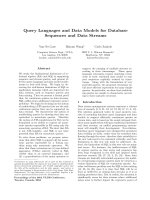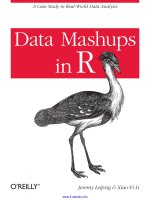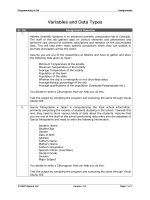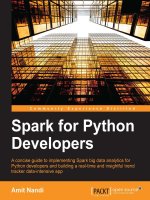www.it-ebooks.info.www.it-ebooks.info.Data Mashups in Rwww.it-ebooks.info.www.it-ebooks.info.Data Mashups in RJeremy Leipzig and Xiao-Yi LiBeijing • Cambridge • Farnham • Köln • Sebastopol • Tokyowww.it-ebooks.info. doc
Bạn đang xem bản rút gọn của tài liệu. Xem và tải ngay bản đầy đủ của tài liệu tại đây (4.93 MB, 38 trang )
www.it-ebooks.info
www.it-ebooks.info
Data Mashups in R
www.it-ebooks.info
www.it-ebooks.info
Data Mashups in R
Jeremy Leipzig and Xiao-Yi Li
Beijing
•
Cambridge
•
Farnham
•
Köln
•
Sebastopol
•
Tokyo
www.it-ebooks.info
Data Mashups in R
by Jeremy Leipzig and Xiao-Yi Li
Copyright © 2011 Jeremy Leipzig and Xiao-Yi Li. All rights reserved.
Printed in the United States of America.
Published by O’Reilly Media, Inc., 1005 Gravenstein Highway North, Sebastopol, CA 95472.
O’Reilly books may be purchased for educational, business, or sales promotional use. Online editions
are also available for most titles (). For more information, contact our
corporate/institutional sales department: (800) 998-9938 or
Editor: Mike Loukides
Production Editor: Kristen Borg
Proofreader: Kristen Borg
Cover Designer: Karen Montgomery
Interior Designer: David Futato
Illustrator: Robert Romano
Printing History:
March 2011: First Edition.
Nutshell Handbook, the Nutshell Handbook logo, and the O’Reilly logo are registered trademarks of
O’Reilly Media, Inc. Data Mashups in R, the image of a black-billed Australian bustard, and related trade
dress are trademarks of O’Reilly Media, Inc.
Many of the designations used by manufacturers and sellers to distinguish their products are claimed as
trademarks. Where those designations appear in this book, and O’Reilly Media, Inc., was aware of a
trademark claim, the designations have been printed in caps or initial caps.
While every precaution has been taken in the preparation of this book, the publisher and authors assume
no responsibility for errors or omissions, or for damages resulting from the use of the information con-
tained herein.
ISBN: 978-1-449-30353-2
[LSI]
1299253461
www.it-ebooks.info
Table of Contents
Introduction . . . . . . . . . . . . . . . . . . . . . . . . . . . . . . . . . . . . . . . . . . . . . . . . . . . . . . . . . . . . . . . . vii
1. Mapping Foreclosures . . . . . . . . . . . . . . . . . . . . . . . . . . . . . . . . . . . . . . . . . . . . . . . . . . . 1
Messy Address Parsing 1
Exploring “streets” 3
Obtaining Latitude and Longitude Using Yahoo 4
Shaking the XML Tree 5
The Many Ways to Philly (Latitude) 6
Using Data Structures 7
Using Helper Methods 7
Using Internal Class Methods 7
Exceptional Circumstances 8
The Unmappable Fake Street 8
No Connection 9
Taking Shape 9
Finding a Usable Map 10
PBSmapping 10
Developing the Plot 11
Preparing to Add Points to Our Map 12
Exploring R Data Structures: geoTable 14
Making Events of Our Foreclosures 15
Turning Up the Heat 15
Factors When You Need Them 16
Filling with Color Gradients 17
2. Statistics of Foreclosure . . . . . . . . . . . . . . . . . . . . . . . . . . . . . . . . . . . . . . . . . . . . . . . . . 19
Importing Census Data 19
Descriptive Statistics 22
Descriptive Plots 23
Correlation 25
Final Thoughts 26
v
www.it-ebooks.info
Appendix: Getting Started . . . . . . . . . . . . . . . . . . . . . . . . . . . . . . . . . . . . . . . . . . . . . . . . . . . . . 27
vi | Table of Contents
www.it-ebooks.info
Introduction
Programmers may spend a good part of their careers scripting code to conform to com-
mercial statistics packages, visualization tools, and domain-specific third-party soft-
ware. The same tasks can force end users to spend countless hours in copy-paste pur-
gatory, each minor change necessitating another grueling round of formatting tabs and
screenshots. Luckily, R scripting offers some reprieve. Because this open source project
garners the support of a large community of package developers, the R statistical pro-
gramming environment provides an amazing level of extensibility. Data from a multi-
tude of sources can be imported into R and processed using R packages to aid statistical
analysis and visualization. R scripts can also be configured to produce high-quality
reports in an automated fashion—saving time, energy, and frustration.
This book will demonstrate how real-world data is imported, managed, visualized, and
analyzed within R. Spatial mashups provide an excellent way to explore the capabilities
of R—encompassing R packages, R syntax, and data structures. Instead of canned
sample data, we will be plotting and analyzing actual current home foreclosure auc-
tions. Through this exercise, we hope to provide an general idea of how the R envi-
ronment works with R packages as well as its own capabilities in statistical analysis.
We will be accessing spatial data in several formats (HTML, XML, shapefiles, and text)
both locally and over the web, to produce a map of home foreclosures and perform
statistical analysis on these events.
vii
www.it-ebooks.info
www.it-ebooks.info
CHAPTER 1
Mapping Foreclosures
Messy Address Parsing
To illustrate how to combine data from disparate sources for statistical analysis and
visualization, let’s focus on one of the messiest sources of data around: web pages.
The Philadelphia sheriff’s office posts foreclosure auctions on its website each month.
How do we collect this data, massage it into a reasonable form, and work with it? First,
create a new folder (for example, ~/Rmashup) to contain our project files. It is helpful
to change the R working directory to your newly created folder.
#In Unix/MacOS
> setwd("~/Documents/Rmashup/")
#In Windows
> setwd("C:/~/Rmashup/")
We can download this foreclosure listings web page from within R (or you may instead
choose to save the raw HTML from your web browser):
> download.file(url=" /> destfile="properties.html")
Here is some of this web page’s source HTML, with addresses highlighted:
6321 Farnsworth St.
62nd Ward
1,379.88 sq. ft. BRT# 621533500 Improvements: Residential Property
<br><b>
HOMER SIMPSON
</b> C.P. January Term, 2006 No. 002619 $27,537.87
Phelan Hallinan & Schmieg, L.L.P.
<hr />
<center><b> 243-467 </b></center>
1402 E. Mt. Pleasant Ave.
50th Ward
approximately 1,416 sq. ft. more or less BRT# 502440300
1
www.it-ebooks.info
The sheriff’s raw HTML listings are inconsistently formatted, but with the right regular
expression we can identify street addresses: notice how they appear alone on a line.
Our goal is to submit viable addresses to the geocoder. Here are some typical addresses
that our regular expression should match:
3509 N. Lee St.
2120-2128 E. Allegheny Ave.
7601 Crittenden St., #E-10
370 Tomlinson Place
2311 N. 33rd St.
6822-24 Old York Rd.
335 W. School House Lane
These are not addresses and should not be matched:
2,700 sq. ft. BRT# 124077100 Improvements: Residential Property
</b> C.P. June Term, 2009 No. 00575
R has built-in functions that allow the use of Perl-type regular expressions. For more
info on regular expressions, see Mastering Regular Expressions (O’Reilly) and Regular
Expression Pocket Reference (O’Reilly).
With some minor deletions to clean up address idiosyncrasies, we should be able to
correctly identify street addresses from the mess of other data contained in proper-
ties.html. We’ll use a single regular expression pattern to do the cleanup. For clarity,
we can break the pattern into the familiar elements of an address (number, name, suffix)
> stNum<-"^[0-9]{2,5}(\\-[0-9]+)?"
> stName<-"([NSEW]\\. )?[0-9A-Z ]+"
> stSuf<-"(St|Ave|Place|Blvd|Drive|Lane|Ln|Rd)(\\.?)$"
> myStPat<-paste(stNum,stName,stSuf,sep=" ")
Note the backslash characters themselves must be escaped with a backslash to avoid
conflict with R syntax. Let’s test this pattern against our examples using R’s grep()
function:
> grep(myStPat,"6822-24 Old York Rd.",perl=TRUE,value=FALSE,ignore.case=TRUE)
[1] 1
> grep(myStPat,"2,700 sq. ft. BRT# 124077100 Improvements: Residential Property",
perl=TRUE,value=FALSE,ignore.case=TRUE)
integer(0)
The result, [1] 1, shows that the first of our target address strings matched; we tested
only one string at a time. We also have to omit strings that we don’t want with our
address, such as extra punctuation (like quotes or commas), or sheriff’s office desig-
nations that follow street names:
> badStrings<-"(\\r| a\\/?[kd]\\/?a.+$| - Premise.+$| assessed as.+$|,
Unit.+|<font size=\"[0-9]\">|Apt\\ +| #.+$|[,\"]|\\s+$)"
2 | Chapter 1: Mapping Foreclosures
www.it-ebooks.info
Test this against some examples using R’s gsub() function:
> gsub(badStrings,'',"119 Hagy's Mill Rd. a/k/a 119 Spring Lane",
perl=TRUE)
[1] "119 Hagy's Mill Rd."
> gsub(badStrings,'',"3229 Hurley St. - Premise A",perl=TRUE)
[1] "3229 Hurley St."
Let’s encapsulate this address parsing into a function that will accept an HTML file
and return a vector, a one-dimensional ordered collection with a specific data type, in
this case character. Copy and paste this entire block into your R console:
#input:html filename
#returns:data frame of geocoded addresses that can be plotted by PBSmapping
getAddressesFromHTML<-function(myHTMLDoc){
myStreets<-vector(mode="character",0)
stNum<-"^[0-9]{2,5}(\\-[0-9]+)?"
stName<-"([NSEW]\\. )?([0-9A-Z ]+)"
stSuf<-"(St|Ave|Place|Blvd|Drive|Lane|Ln|Rd)(\\.?)$"
badStrings<-paste(
"(\\r| a\\/?[kd]\\/?a.+$| - Premise.+$| assessed as.+$|,",
"Unit.+|<font size=\"[0-9]\">|Apt\\ +| #.+$|[,\"]|\\s+$)")
myStPat<-paste(stNum,stName,stSuf,sep=" ")
for(line in readLines(myHTMLDoc)){
line<-gsub(badStrings,'',line,perl=TRUE)
matches<-grep(myStPat,line,perl=TRUE,
value=FALSE,ignore.case=TRUE)
if(length(matches)>0){
myStreets<-append(myStreets,line)
}
}
myStreets
}
We can test this function on our downloaded HTML file:
> streets<-getAddressesFromHTML("properties.html")
> length(streets)
[1] 1264
Exploring “streets”
R has very strong support for vector subscripting. To access the first six foreclosures
on our list:
> streets[1:6]
[1] "6321 Farnsworth St." "5711 Anderson St." "1250 S. 24th St."
[4] "1546 S. 26th St." "2401 Pennsylvania Ave." "812 S. 58th St."
c() forms a vector from its arguments. Subscripting a vector with another vector does
what you’d expect—here’s how to form a vector from the first and last elements of the
list:
> streets[c(1,length(streets))]
[1] "6321 Farnsworth St." "7455 Ruskin Rd."
Messy Address Parsing | 3
www.it-ebooks.info
Here’s how to select foreclosures that are on a “Place”:
> streets[grep("Place",streets)]
[1] "1430 Dondill Place" "370 Tomlinson Place" "8025 Pompey Place"
[4] "7330 Boreal Place" "2818 Ryerson Place" "8416 Suffolk Place"
To order foreclosures by street number, dispense with non-numeric characters, cast as
numeric, and use order() to get the indices.
> streets[order(as.numeric(gsub("[^0-9].+",'',streets)))]
[1] "21 S. 51st St." "22 E. Garfield St."
[3] "26 W. Manheim St." "26 N. Felton St."
[5] "30 S. 58th St." "31 N. Columbus Blvd."
[1259] "12122 Barbary Rd." "12223 Medford Rd."
[1261] "12430 Wyndom Rd." "12701 Medford Rd."
[1263] "12727 Medford Rd." "13054 Townsend Rd."
Obtaining Latitude and Longitude Using Yahoo
To plot our foreclosures on a map, we’ll need to get latitude and longitude coordinates
for each street address. Yahoo Maps provides this functionality (called “geocoding”)
as a REST-enabled web service. Via HTTP, the service accepts a URL containing a
partial or full street address, and returns an XML document with the relevant infor-
mation. It doesn’t matter whether a web browser or a robot is submitting the request,
as long as the URL is correctly formatted. The URL must contain an appid parameter
and as many street address arguments as are known.
/>_JXxQP6rxl.fBFGgCdNjoDMACQA &street=1+South+Broad+St&city=Philadel
phia&state=PA
In response we get:
<?xml version="1.0"?>
<ResultSet xmlns:xsi=" /> xmlns="urn:yahoo:maps"
xsi:schemaLocation=
"urn:yahoo:maps /> <Result precision="address">
<Latitude>39.951405</Latitude>
<Longitude>-75.163735</Longitude>
<Address>1 S Broad St</Address>
<City>Philadelphia</City>
<State>PA</State>
<Zip>19107-3300</Zip>
<Country>US</Country>
</Result>
</ResultSet>
4 | Chapter 1: Mapping Foreclosures
www.it-ebooks.info
To use this service with your mashup, you must sign up with Yahoo! and receive an
Application ID. Use that ID in with the appid parameter of the request URL. You can
sign up at />Shaking the XML Tree
Parsing well-formed and valid XML should be less convoluted than parsing the sheriff’s
HTML. An XML parsing package is available for R; here’s how to install it from CRAN’s
repository:
> install.packages("XML")
> library("XML")
If you are behind a firewall or proxy and getting errors:
On Unix, set your http_proxy environment variable.
On Windows, try the custom install R wizard with the “internet2” op-
tion instead of “standard”. You can find additional information at http:
//cran.r-project.org/bin/windows/base/rw-FAQ.html#The-Internet
-download-functions-fail_00.
Our goal is to extract values contained within the <Latitude> and <Longitude> leaf
nodes. These nodes live within the <Result> node, which lives inside a <ResultSet>
node, which itself lies inside the root node.
To find an appropriate library for getting these values, call library(help=XML). This
function lists the functions in the XML package.
> library(help=XML) #hit space to scroll, q to exit
> ?xmlTreeParse
You’ll see that the function xmlTreeParse will accept an XML file or URL and return an
R structure. After inserting your Yahoo App ID, paste in this block:
> library(XML)
> appid<-'<put your appid here>'
> street<-"1 South Broad Street"
> requestUrl<-paste(
" /> appid,
"&street=",
URLencode(street),
"&city=Philadelphia&state=PA"
,sep="")
> xmlResult<-xmlTreeParse(requestUrl,isURL=TRUE)
Shaking the XML Tree | 5
www.it-ebooks.info
Are you behind a Windows firewall or proxy and this example is giving
you trouble?
xmlTreeParse has no respect for your proxy settings. Do the following:
> Sys.setenv("http_proxy" = "http://myProxyServer:myProxyPort")
or if you use a username/password:
> Sys.setenv("http_proxy"="http://username:password@proxyHost:proxyPort″)
You need to install the cURL package to handle fetching web pages:
> install.packages("RCurl")
> library("RCurl")
In the example above, change:
> xmlResult<-xmlTreeParse(requestUrl,isURL=TRUE)
to:
> xmlResult<-xmlTreeParse(getURL(requestUrl))
The XML package can perform event- or tree-based parsing. However, because we only
need two bits of information (latitude and longitude), we can go straight for the jugular
by gleaning what we can from the data structure that xmlTreeParse returns:
> str(xmlResult)
List of 2
$ doc:List of 3
$ file :List of 1
$ Result:List of 7
$ Latitude :List of 1
$ text: list()
attr(*, "class")= chr [1:5] "XMLTextNode" "XMLNode" "RXMLAb
attr(*, "class")= chr [1:4] "XMLNode" "RXMLAbstractNode" "XMLA
$ Longitude:List of 1
$ text: list()
attr(*, "class")= chr [1:5] "XMLTextNode" "XMLNode" "RXMLAb
attr(*, "class")= chr [1:4] "XMLNode" "RXMLAbstractNode" "XMLA
(snip)
That’s kind of a mess, but we can see that our Longitude and Latitude are Lists inside
of Lists inside of a List inside of a List.
Tom Short’s R reference card, an invaluable resource (available at http://cran.r-project
.org/doc/contrib/Short-refcard.pdf), tells us to get the name element in list x of a list in R:
x[["name"]].
The Many Ways to Philly (Latitude)
There are three different ways we can extract the latitude and longitude coordinates
from our XML result.
6 | Chapter 1: Mapping Foreclosures
www.it-ebooks.info
Using Data Structures
Using the indexing list notation from R, we can get to the nodes we need:
> lat<-xmlResult[['doc']][['ResultSet']][['Result']][['Latitude']][['text']]
> long<-xmlResult[['doc']][['ResultSet']][['Result']][['Longitude']][['text']]
> lat
39.951405
This looks good, but examine this further:
> str(lat)
list()
- attr(*, "class")= chr [1:5] "XMLTextNode" "XMLNode" "RXMLAbstractNode" "XML
Although it has a decent display value, this variable still considers itself an XMLNode and
contains no index to obtain the raw leaf value we want—the descriptor just says
list() instead of something we can use (like $lat). We’re not quite there yet.
Using Helper Methods
Fortunately, the XML package offers a method to access the leaf value—xmlValue:
> lat<-xmlValue(xmlResult[['doc']][['ResultSet']][['Result']][['Latitude']])
> str(lat)
chr "39.951405"
Using Internal Class Methods
There are usually multiple ways to accomplish the same task in R. Another means to
get to our character lat/long data is to use the value method provided by the node itself:
> lat<-xmlResult[['doc']][['ResultSet']][['Result']][['Latitude']][['text']]$value
If we were really clever, we would have understood that the XML doc class provided
us with useful methods all the way down! Try neurotically holding down the tab key
after typing this:
> lat<-xmlResult$ (now hold down the tab key)
xmlResult$doc xmlResult$dtd
(let's go with doc and start looking for more methods using $)
> lat<-xmlResult$doc$
With enough experimentation, we can get all the way to the result we are looking for:
> lat<-xmlResult$doc$children$ResultSet$children
$Result$children$Latitude$children$text$value
> str(lat)
chr "39.951405"
The Many Ways to Philly (Latitude) | 7
www.it-ebooks.info
We get the same usable result using raw data structures with helper methods, or internal
object methods. In a more complex or longer tree structure, we might have also used
event-based or XPath-style parsing to get to our value. You should always begin by
trying the approaches that you find most intuitive.
Exceptional Circumstances
To ensure that our script runs smoothly, we need to deal with the possibility that an
address cannot be geocoded or that our conversation with the geocoder will be inter-
rupted.
The Unmappable Fake Street
Now we have to deal with the problem of bad street addresses—either the sheriff’s
office entered a typo or our parser let a bad street address pass (see ooapis
.com/MapsService/V1/geocode?appid=YD-9G7bey8_JXxQP6rxl.fBFGgCdNjoD
MACQA &street=1+Fake+St&city=Philadelphia&state=PA).
The Yahoo documentation states that when confronted with an address that cannot
be mapped, the geocoder will return coordinates pointing to the center of the city. Note
the precision attribute of the result is “zip” instead of address and there is a warning
attribute as well:
<?xml version="1.0"?>
<ResultSet xmlns:xsi="
xmlns="urn:yahoo:maps"
xsi:schemaLocation=
"urn:yahoo:maps /> <Result precision="zip"
warning="The street could not be found. Here is the center of the city.">
<Latitude>39.952270</Latitude>
<Longitude>-75.162369</Longitude>
<Address>
</Address>
<City>Philadelphia</City>
<State>PA</State>
<Zip></Zip>
<Country>US</Country>
</Result>
</ResultSet>
Paste in the following:
> street<-"1 Fake St"
> requestUrl<-paste(
" /> appid,
"&street=",
URLencode(street),
"&city=Philadelphia&state=PA"
,sep="")
8 | Chapter 1: Mapping Foreclosures
www.it-ebooks.info
We need to get a hold of the attribute tags within <Result> to distinguish bad geocoding
events, or else we could accidentally record events in the center of the city as foreclo-
sures. By reading the RSXML FAQ, it becomes clear we need to turn on the addAttri
buteNamespaces parameter to our xmlTreeParse call if we are to see the precision tag:
> xmlResult<-xmlTreeParse(requestUrl,isURL=TRUE,addAttributeNamespaces=TRUE)
Now we can dig down to get that precision tag, which is an element of $attributes, a
named list:
> xmlResult$doc$children$ResultSet$children$Result$attributes['precision']
precision
"zip"
We can add this condition to our geocoding function:
> if(xmlResult$doc$children$ResultSet$children
$Result$attributes['precision'] == 'address'){
cat("I have address precision!\n")
}else{
cat("I don't know where this is!\n")
}
No Connection
Finally we need to account for unforeseen exceptions—such as losing our Internet
connection or the Yahoo web service failing to respond. It is not uncommon for this
free service to drop out when bombarded by requests. A tryCatch clause will alert us if
this does happen and prevent bad data from getting into our results.
> tryCatch({
xmlResult<-xmlTreeParse(requestUrl,isURL=TRUE,addAttributeNamespaces=TRUE)
# other code
}, error=function(err){
cat("xml parsing or http error:", conditionMessage(err), "\n")
})
We will compile all this code into a single function once we know how to merge it with
a map (see “Developing the Plot” on page 11).
Taking Shape
To display a map of Philadelphia with our foreclosures, we need to find a polygon of
the county as well as a means of plotting our lat/long coordinates onto it. Both of these
requirements are met by the ubiquitous ESRI shapefile format. The term shapefile col-
lectively refers to a .shp file (which contains polygons), and related files that store other
features, indices, and metadata.
Taking Shape | 9
www.it-ebooks.info
Finding a Usable Map
Googling “philadelphia shapefile” returns several promising results including this page:
/>The “Philadelphia Tracts” maps on that website seem useful because they include US
Census Tract information. We can use these tract IDs to link to other census data.
Tracts are standardized to contain roughly 1500‒8000 people, so densely populated
tracts tend to be smaller. This particular shapefile is especially appealing because the
map “projection” uses the same WGS84 Lat/Long coordinate system that our address
geocoding service uses, as opposed to a “state plane coordinate system,” which can be
difficult to transform. Transformations require the rgdal package and GDAL executa-
bles.
Save and unzip the following file to your project directory: />shpfiles/phila_tracts_2000.zip.
PBSmapping
PBSmapping is a popular R package that offers several means of interacting with spatial
data. It relies on some base functions from the maptools package to read ESRI shape-
files, so we need both packages:
> install.packages(c("maptools","PBSmapping"))
As with other packages, we can see the functions using library(help=PBSmapping) and
view function descriptions using ?topic: (see />PBSmapping/index.html).
We can use str to examine the structure of the shapefile imported by PBS
mapping::importShapeFile:
> library(PBSmapping)
PBS Mapping 2.61.9 Copyright (C) 2003-2010 Fisheries and Oceans Canada
PBS Mapping comes with ABSOLUTELY NO WARRANTY;
for details see the file COPYING.
This is free software, and you are welcome to redistribute
it under certain conditions, as outlined in the above file.
A complete user guide 'PBSmapping-UG.pdf' is located at
/Library/Frameworks/R.framework/Versions/2.12/Resources/library/ \
PBSmapping/doc/PBSmapping-UG.pdf
To see demos, type '.PBSfigs()'.
10 | Chapter 1: Mapping Foreclosures
www.it-ebooks.info
Packaged on 2010-06-23
Pacific Biological Station, Nanaimo
> myShapeFile<-importShapefile("tracts2000",readDBF=TRUE)
Loading required package: maptools
Loading required package: foreign
Loading required package: sp
> str(myShapeFile)
Classes 'PolySet' and 'data.frame': 16290 obs. of 5 variables:
$ PID: int 1 1 1 1 1 1 1 1 1 1
$ SID: int 1 1 1 1 1 1 1 1 1 1
$ POS: int 1 2 3 4 5 6 7 8 9 10
$ X : num -75.2 -75.2 -75.2 -75.2 -75.2
$ Y : num 39.9 39.9 39.9 40 40
- attr(*, "PolyData")=Classes 'PolyData' and 'data.frame': 381 obs. of 9 var
$ PID : int 1 2 3 4 5 6 7 8 9 10
$ ID : Factor w/ 381 levels "1","10","100", : 1 112 223 316 327 338
$ FIPSSTCO: Factor w/ 1 level "42101": 1 1 1 1 1 1 1 1 1 1
$ TRT2000 : Factor w/ 381 levels "000100","000200", : 1 2 3 4 5 6 7 8 9
$ STFID : Factor w/ 381 levels "42101000100", : 1 2 3 4 5 6 7 8 9 10
$ TRACTID : Factor w/ 381 levels "1","10","100", : 1 114 226 313 327 337
$ PARK : num 0 0 0 0 0 0 0 0 0 0
$ OLDID : num 1 1 1 1 1 1 1 1 1 1
$ NEWID : num 2 2 2 2 2 2 2 2 2 2
- attr(*, "parent.child")= num 1 1 1 1 1 1 1 1 1 1
- attr(*, "shpType")= int 5
- attr(*, "prj")= chr "Unknown"
- attr(*, "projection")= num 1
While the shapefile itself consists of 16290 points that make up Philadelphia, it appears
that much of the polygon data associated with this shapefile is stored as an attribute of
myShapeFile. We should set that to a top level variable for easier access:
> myPolyData<-attr(myShapeFile,"PolyData")
Plotting this shapefile is a one-liner (see Figure 1-1):
> plotPolys(myShapeFile)
Let’s spruce that up a bit (see Figure 1-2):
> plotPolys(myShapeFile,axes=FALSE,bg="beige",main="Philadelphia County\n
January 2011 Foreclosures",xlab="",ylab="")
Developing the Plot
With foreclosures represented as geographic coordinates, the addPoints function in the
PBSmapping package can plot each foreclosure as a point on the shapefile, provided
the function is given a properly formatted data frame object.
Developing the Plot | 11
www.it-ebooks.info
Preparing to Add Points to Our Map
To use the PBSmapping’s addPoints function, the reference manual suggests that we
treat our foreclosures as EventData. The EventData format is a standard R data frame
(more on data frames later) with required columns X, Y, and a unique row identifier,
an event ID (EID). With this in mind, we can write a function around our geocoding
code that will accept a list of streets and return a kosher EventData-like data frame:
#input:vector of streets
#output:data frame containing lat/longs in PBSmapping-like format
> geocodeAddresses<-function(myStreets){
appid<-'<put your appid here>'
myGeoTable<-data.frame(
address=character(),lat=numeric(),long=numeric(),EID=numeric())
for(myStreet in myStreets){
requestUrl<-paste(
" /> appid,
"&street=",URLencode(myStreet),
"&city=Philadelphia&state=PA",sep="")
cat("geocoding:",myStreet,"\n")
Figure 1-1. The tracts2000.shp shapefile rendered by plotPolys
12 | Chapter 1: Mapping Foreclosures
www.it-ebooks.info
tryCatch({
xmlResult<-
xmlTreeParse(requestUrl,isURL=TRUE,addAttributeNamespaces=TRUE)
geoResult<-xmlResult$doc$children$ResultSet$children$Result
if(geoResult$attributes['precision'] == 'address'){
lat<-xmlValue(geoResult[['Latitude']])
long<-xmlValue(geoResult[['Longitude']])
myGeoTable<-rbind(myGeoTable,
data.frame(address = myStreet, Y = lat, X =
long,EID=NA))
}
}, error=function(err){
cat("xml parsing/http error:", conditionMessage(err), "\n")
})
Sys.sleep(0.5) #this pause helps keep Yahoo happy
}
#use built-in numbering as the event id for PBSmapping
myGeoTable$EID<-as.numeric(rownames(myGeoTable))
myGeoTable
}
Figure 1-2. The shapefile rendered without axes, given a new background color and a main title
Developing the Plot | 13
www.it-ebooks.info
After pasting the above geocodeAddresses function into your R console, enter in the
following (make sure you still have a streets vector from the parsing chapter):
> geoTable<-geocodeAddresses(streets) geocoding: 410 N. 61st St.
geocoding: 6321 Farnsworth St.
geocoding: 5711 Anderson St.
geocoding: 1250 S. 24th St.
geocoding: 1546 S. 26th St.
geocoding: 2401 Pennsylvania Ave.
geocoding: 812 S. 58th St.
geocoding: 3509 N. Lee St.
(10 minutes later)
gecoding: 7455 Ruskin Rd.
Exploring R Data Structures: geoTable
A data frame is R’s interpretation of a spreadsheet:
> names(geoTable)
[1] "address" "Y" "X" "EID"
> nrow(geoTable)
[1] 1264
The first row:
> geoTable[1,]
address Y X EID
1 6321 Farnsworth St. 40.032400 -75.067243 1
X and Y from the first five rows:
> geoTable[1:5,c("X","Y")]
X Y
1 -75.067243 40.032400
2 -75.159509 40.051511
3 -75.183899 39.937076
4 -75.188141 39.933655
5 -75.177794 39.966036
The cell in the 4th column, 4th row:
> geoTable[4,4]
[1] 4
The second column, also known as “Y”:
> geoTable[,2]
#or#
> geoTable$Y
[1] 40.032400 40.051511 39.937076 39.933655 39.966036 39.948570 40.003219 40.011250
[9] 39.975206 39.999268 39.997490 39.993409 39.978768 39.991603 39.987332 39.992144
14 | Chapter 1: Mapping Foreclosures
www.it-ebooks.info
Making Events of Our Foreclosures
Our geoTable is similar in structure to an EventData object but we need to use the
as.EventData function to complete the conversion.
> addressEvents<-as.EventData(geoTable,projection=NA)
Error in as.EventData(geoTable, projection = NA) :
Cannot coerce into EventData.
One or more columns contains factors where they are not allowed.
Columns that cannot contain factors: EID, X, Y.
Oh snap! The dreaded “factor feature” in R strikes again. When a data frame column
contains factors, its elements are represented using indices that refer to levels, distinct
values within that column. The as.EventData method is expecting columns of type
numeric, not factor. Never transform from factors to numeric like this:
as.numeric(myTable$factorColumn) #don't do this!
This is an extremely common mistake—this will merely return numeric indices used
to refer to the levels—but you want the levels themselves:
> geoTable$X<-as.numeric(levels(geoTable$X))[geoTable$X] #do this
> geoTable$Y<-as.numeric(levels(geoTable$Y))[geoTable$Y]
With numeric lat/longs in hand, we can quantitatively explore this geographic data.
What is the northernmost (highest latitude) of our foreclosures?
> geoTable[geoTable$Y==max(geoTable$Y),]
address Y X EID
1151 100 County Line Rd. 40.13754 -75.0145 1151
The EventData casting should work now that our columns are numeric.
> addressEvents<-as.EventData(geoTable,projection=NA)
> addPoints(addressEvents,col="red",cex=.5)
The EventData is rendered as tiny circles using addPoints (see Figure 1-3).
Turning Up the Heat
PBSmapping allows us to see in which polygons/tracts our foreclosures were plotted.
Using this data, we can represent the intensity of foreclosure events as a heatmap. We
can use the head function to inspect the first few rows of a data frame:
> addressPolys<-findPolys(addressEvents,myShapeFile)
> head(addressPolys)
EID PID SID Bdry
1 37 1 1 0
2 780 1 1 0
3 781 1 1 0
4 1164 1 1 0
5 1178 1 1 0
6 1179 1 1 0
Turning Up the Heat | 15
www.it-ebooks.info









